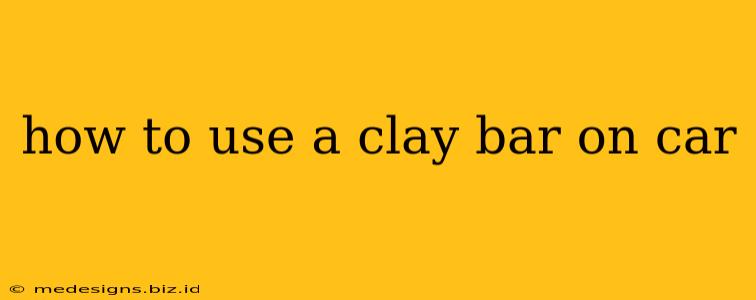Want that showroom shine? A clay bar treatment is a crucial step in achieving a truly flawless car finish. This detailing technique removes embedded contaminants that even the best wash can't tackle, leaving your paint feeling unbelievably smooth. But using a clay bar incorrectly can scratch your paint. This comprehensive guide will walk you through the process, ensuring you achieve professional results without damaging your vehicle's finish.
What is a Clay Bar and Why Use It?
A clay bar is a synthetic polymer that acts like a magnet, attracting and lifting microscopic contaminants from your car's paint. These contaminants, including industrial fallout, tree sap, brake dust, and even road grime, are too small to see but can dull your paint and prevent a truly smooth surface. Think of it as a deep clean for your paint before polishing and waxing.
Benefits of Clay Bar Treatment:
- Removes embedded contaminants: Gets rid of imperfections a wash can't touch.
- Prepares for polishing and waxing: Creates a perfectly smooth surface for optimal results.
- Improves paint shine and clarity: Reveals the true depth and brilliance of your paint.
- Enhances paint protection: Allows waxes and sealants to bond better.
Essential Supplies for Clay Bar Detailing:
Before you begin, gather these essential supplies:
- Clay Bar: Choose a quality clay bar specifically designed for automotive use. Different types of clay exist – some are more aggressive for heavily contaminated surfaces, while others are gentler for lightly soiled paint.
- Detailing Spray: A high-quality detailing spray acts as a lubricant, preventing the clay bar from scratching the paint. Use a product specifically designed for clay bar use.
- Microfiber Towels: You'll need several plush, clean microfiber towels. One for lubricating the clay bar and others for wiping away the removed contaminants.
- Buckets: Two buckets are ideal: one for clean detailing spray and the other (optional) for rinsing the clay bar.
- Optional: Quick Detailer: This can add extra lubricity to the process, especially in hot climates.
Step-by-Step Guide to Using a Clay Bar:
1. Prepare Your Car: Wash your car thoroughly. This is crucial; clay barring a dirty car can introduce scratches. Dry the car completely.
2. Divide and Conquer: Work in small sections (approximately 2x2 feet) to prevent the clay bar from drying out.
3. Lubricate the Surface: Spray a liberal amount of detailing spray onto the section you're working on. The surface should be consistently wet.
4. Knead the Clay: Knead the clay bar to make it pliable. This will help maintain its effectiveness and prevent tearing.
5. Glide the Clay: Gently glide the clay bar across the lubricated surface, using light, even pressure. Avoid pressing down too hard; only enough to feel some resistance. If you feel resistance, that means the clay is picking up contaminants. If you don't feel resistance, there may not be a need to use a clay bar on that specific part of the vehicle.
6. Fold the Clay: Frequently fold the clay bar to expose a clean surface. This prevents you from spreading previously picked-up contaminants back onto your paint.
7. Inspect the Surface: Check the clay bar regularly. If the clay becomes too dirty, you will need to knead it and/or replace it. You should be able to run your hand over the surface and feel a significant difference in smoothness. Continue until the surface feels completely smooth.
8. Dry and Repeat: Wipe away any residue with a clean microfiber towel and repeat steps 3-7 on the remaining sections of your car.
9. Final Inspection: Once the entire car is clayed, inspect for any remaining imperfections. You may need to repeat the process on stubborn areas.
10. Post-Claying: After claying, your car is ready for polishing and waxing to seal in the smooth, clean finish and protect your paint.
Tips for Success:
- Work in the shade: Direct sunlight can cause the detailing spray to dry too quickly.
- Use enough lubricant: Insufficient lubrication is the main cause of clay bar scratches.
- Don't reuse heavily contaminated clay: Discard or replace the clay bar if it becomes heavily contaminated.
- Practice on a less visible area first: Get a feel for the process before working on the entire car.
By following these steps and tips, you can achieve a professional-level clay bar treatment, leaving your car with a stunning, smooth, and contaminant-free finish. Remember, patience is key! Take your time and enjoy the process. The rewarding result will be a car that looks its absolute best.
